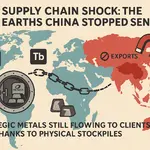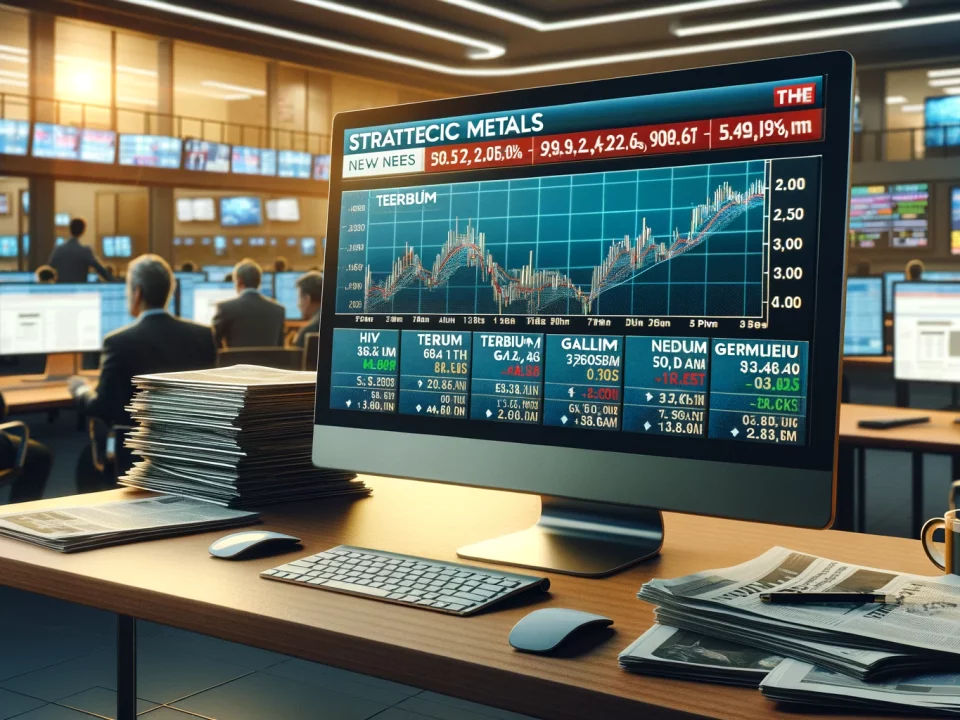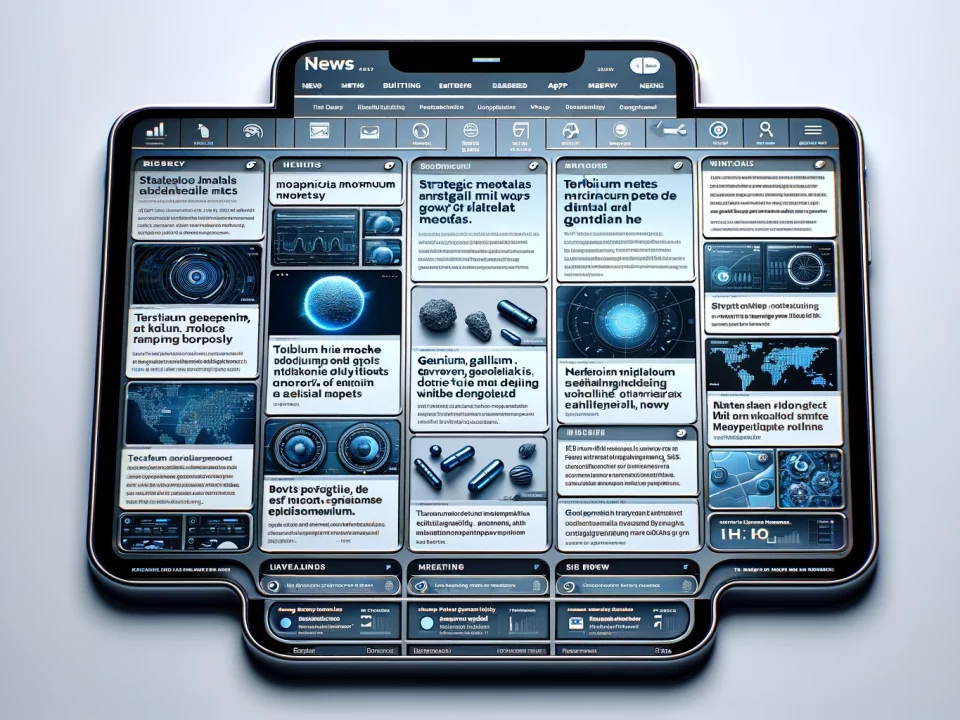
Rare Earth Shortages Increase Gains for Private Investors
June 24, 2025
Let’s talk about Defense (Metals)
July 1, 2025China’s latest export data reveals that no gallium shipments cleared customs in May, and only minimal amounts of germanium were exported, underscoring tightening global supply constraints for critical minerals. Meanwhile, the EU is advancing a joint procurement platform under the Critical Raw Materials Act (CRMA) to stabilize domestic industry supply.
All this and more in our weekly round-up from the newsroom.
CHINA: GALLIUM EXPORTS DROP TO ZERO IN MAY –
Zero gallium shipments cleared Chinese customs in May, while germanium exports remained sharply reduced, according to the latest customs data. Both metals are crucial to a range of high-tech industries, including semiconductor manufacturing, fiber optics, and infrared optics. China is the world’s leading producer of both gallium and germanium.
Germanium exports declined by more than 60% year-over-year, totaling 675 kg, compared to 1,822 kg in May 2024. The primary destination was Japan with 600 kg, followed by Germany, with smaller volumes shipped to Russia and Canada. In contrast, gallium exports, which stood at 6,210 kg in May 2024, dropped to zero in May 2025.
China introduced export licensing requirements for both metals in 2023, with processing times officially estimated at 45 working days. However, industry experts report that some exporters have experienced significantly longer waiting times. In December 2024, China escalated its controls by banning all exports of gallium, germanium, and antimony to the United States. Analysts widely view the move as a response to U.S. restrictions on the export of advanced chipmaking technology to China.
May data showed a decline in several critical mineral commodities, including rare earth magnets and heavy rare earth elements, which have been subject to export controls since April.
UNITED STATES AND ANGOLA STRENGTHENING STRATEGIC METALS SUPPLY CHAINS:
Rare earth mined in Africa to be refined in the U.S. to meet rising demand from civilian and defense sectors.
British mining company Pensana and U.S.-based American Resources Corporation have announced a strategic collaboration aimed at enhancing the resilience and independence of Western rare earth supply chains.
The partnership is designed to help meet the rapidly growing demand for critical minerals from both civilian and military industries in the United States and allied nations, the companies said in a joint press release.
Under the agreement, Pensana will supply up to 20,000 metric tons per year of mixed rare earth carbonate from its Longonjo mine in Angola.
The material will be refined in the U.S. using advanced processing technology developed by ReElement Technologies, a subsidiary of American Resources. ReElement’s method, derived initially from a pharmaceutical process developed by Purdue, is positioned as a more environmentally sustainable alternative to conventional solvent extraction.
The initial supply term is set for a period of five years.
This announcement comes just days after Pensana signed a similar offtake agreement to deliver another 20,000 tons of rare earth carbonate to a trading firm affiliated with the Toyota Group.
ReElement, for its part, also recently revealed a new funding partnership. Novare Holdings, a South African investment company, has committed a multimillion-dollar investment to support the expansion of ReElement’s refinery in Indiana. The two firms are also jointly planning the development of Africa’s first integrated critical minerals refinery.
CANADA TO LEVERAGE STRATEGIC METALS TO HELP MEET NATO SPENDING GOALS:
In an interview with CNN on the sidelines of the NATO summit in The Hague, Canadian Prime Minister Mark Carney emphasized Canada’s strategic advantage in critical minerals as a key lever to help the country meet NATO’s defense spending targets. At the summit, the alliance members are considering raising the minimum defense spending target from 2% to 5% of each country’s gross domestic product.
The proposed increase includes 3.5% for core defense investments and 1.5% for related infrastructure. For Canada, this would amount to an estimated annual commitment of approximately $109 billion (CAD 150 billion), according to Carney.
The Prime Minister argues that investments in Canada’s critical minerals sector and related transportation infrastructure, such as ports, railways, bridges, and roads, could help achieve the 1.5 °C target.
These infrastructure and supply chain improvements are essential for supporting both domestic defense capabilities and NATO’s broader strategic needs, as they align with the alliance’s resource strategy.
NATO’s Growing Focus on Critical Minerals:
In 2024, NATO identified 12 critical minerals essential to the alliance’s defense industry. Among them are, for example, germanium for infrared optics, rare earth elements for magnets, and titanium for alloys and ammunition production.
Canada could become a key supplier of the raw materials essential to NATO’s defense priorities, as it is one of the few nations with confirmed reserves of a broad range of critical minerals, including all 12 prioritized by NATO.
Already today, Canada is a leading producer of cobalt and graphite, both of which are on NATO’s list, as well as multiple other commodities, according to the U.S. Geological Survey.
EUROPE: STRATEGIC METALS PROCUREMENT CLOSE TO LAUNCH –
In May 2024, the European Union’s Critical Raw Materials Act (CRMA) took effect. With this legislative package, the EU aims to strengthen its raw material supply chains amid growing geopolitical uncertainty. In addition to setting targets for domestic mining and recycling, the CRMA is designed to facilitate joint procurement of critical materials by companies.
The European Commission has now announced that the corresponding platform will officially launch next Week, on July 2.
The platform will cover not only rare earth elements, lithium, and other key minerals but also energy products such as hydrogen and natural gas. According to the EU, the system is designed to match supply and demand declarations from participating companies and will provide support services for joint purchasing and brokerage.
Earlier this year, the European Commission awarded contracts for the development of the platform to PricewaterhouseCoopers and a Slovak software company. The system builds on the experience of AggregateEU, a joint gas purchasing platform launched in the spring of 2023 in response to the energy crisis following Russia’s invasion of Ukraine. However, the European Court of Auditors later criticized certain aspects of AggregateEU, raising questions about its effectiveness in achieving its stated goals.
Mixed Reactions to Joint Raw Material Procurement:
The joint procurement mechanism under the CRMA has received a mixed reception since its announcement. Proponents argue that it could give the EU greater leverage in the global market. Camille Defard, head of the energy center at the Jacques Delors Institute, told Euractiv that the platform could strengthen the EU’s negotiating power.
Similarly, André Wolf, a senior economist at the Centre for European Policy, suggested it could serve as a counterbalance to the opaque and China-dominated rare earth market.
However, industry voices have raised concerns. Benedikt Sobotka, then-CEO of Eurasian Resources Group, told the Financial Times that procurement needs vary significantly between companies, making a one-size-fits-all platform difficult to implement. He also pointed out that most mineral processing currently takes place outside Europe, posing a structural challenge to the initiative.
Other executives, according to the Financial Times (Paywall), argued that the EU should focus first on expanding recycling and circular economy solutions before introducing more raw materials into the supply chain.
AUSTRALIA: RARE EARTH PROJECT RECEIVES FINAL APPROVAL –
Production could start as early as 2027. Refining to take place in the U.S.
The Government of Victoria has granted final regulatory approval for Phase 1 of Astron Corporation’s Donald Rare Earths and Mineral Sands Project, located in the Wimmera region of western Victoria. This milestone clears the way for the project’s construction and operation to move forward. According to a company announcement, Astron plans to make a final investment decision later in 2025 once financing has been secured. If development proceeds as expected, the first production is expected to begin by 2027.
The approved work plan outlines the scope and scale of the mining and processing operations. It also includes a risk management strategy that addresses environmental protection and public safety, as the type of deposit contains radioactive material.
Mineral sand deposits are a significant source of rare earth elements (REEs), as well as titanium and zirconium. However, they also contain trace amounts of radioactive elements, including thorium and uranium. Astron has clarified that it will only produce rare earth element concentrates and heavy mineral concentrates and not refine or engage with radioactive components as part of its operations.
The Donald Project is being co-developed with U.S.-based Energy Fuels, a company historically focused on uranium but now expanding into rare earths and other strategic minerals. Under current agreements, Energy Fuels will secure 100% of the rare earth output from Phase 1 of the project. The concentrate will be shipped to the United States for further processing at Energy Fuels’ facility in Utah.
UNITED STATES PUSHES AHEAD WITH DEEP SEA MINING:
In April, U.S. President Donald Trump issued an Executive Order declaring deep-sea mining a key element of the nation’s mineral resource strategy. The order aims to strengthen the domestic supply of critical minerals by expanding national capacities for deep-sea extraction and streamlining permitting processes, all while maintaining existing environmental protections.
In line with this directive, the U.S. Department of the Interior announced on Wednesday that it will revise regulations covering all stages of deep-sea mining, from initial exploration to full-scale production.
Depending on the project, the updated rules promise time savings ranging from two months to over a year. The initiative is being supported by the U.S. Geological Survey (USGS), which will contribute up-to-date research on critical minerals and potential environmental impacts associated with deep-sea mining. This method of resource extraction remains a subject of controversy on the global stage, as its ecological consequences are still poorly understood.
CANADA: SENATE PASSES BILL TO FAST-TRACK STRATEGIC METALS PROJECTS:
The Canadian Senate has passed Bill C-5, Prime Minister Mark Carney’s first significant piece of legislation, without amendments. The bill significantly alters Canada’s project approval process by enabling the Cabinet to expedite the approval of infrastructure and resource projects deemed to be in the national interest.
Projects added to a new federal schedule will bypass specific provisions of existing laws, thereby consolidating approvals and reducing regulatory delays. The bill also implements annual independent reviews to track the progress and compliance of each project.
Although the legislation doesn’t name specific initiatives, Carney has indicated that it could support energy projects, mines, ports, and transportation infrastructure, according to the Financial Post. The timing aligns with Canada’s push to meet the newly agreed-upon NATO defense spending targets, which are rising from 2% to 5% of GDP.
Carney argued earlier this Week that expanding Canada’s critical minerals sector and related infrastructure can help fulfill the alliance’s goals, particularly the 1.5% infrastructure component.
However, Indigenous senators and leaders have voiced strong opposition to Bill C-5, citing a lack of consultation, the absence of guaranteed consent, and risks to Indigenous rights, according to the Canadian Broadcasting Corporation. Critics warn that fast-tracking development without proper oversight undermines environmental protection and reconciliation efforts.
UNITED STATES AND CHINA REACH FRAMEWORK DEAL ON RARE EARTH:
There are signs of movement in the ongoing trade dispute between the United States and China. According to media reports, the two countries have been engaged in talks since May and have now reached a preliminary framework agreement that could accelerate the export of rare earth elements. Bloomberg reports that the agreement may ease restrictions imposed in April on seven heavy rare earths, including terbium, a critical component used in magnets and high-tech applications.
However, this decline was not due to an outright export ban but rather a new licensing regime introduced by China. Since April, rare earth materials covered by the rules require official export licenses, which can take up to 45 business days to process. The delays have already led to production disruptions in Western industries reliant on these materials.
While the licensing rules apply to all destination countries, sources suggest that the U.S. may soon benefit from expedited procedures. Bloomberg quoted U.S. Commerce Secretary Howard Lutnick as saying: “They will supply us with rare earths,” and once that happens, “we will roll back our countermeasures.” Those countermeasures include tariffs on aircraft components and chip-design software.
Still, a complete resolution of the broader trade conflict remains distant. Tensions have been running high since the U.S. announced a new wave of punitive tariffs on Chinese goods on April 2. Although some of those duties were temporarily suspended, they are currently set to take effect on August 12.
Figure of the Week: – 74% – of global tantalum production comes from artisanal mining in Africa. This critical raw material is used in products such as smartphones.






